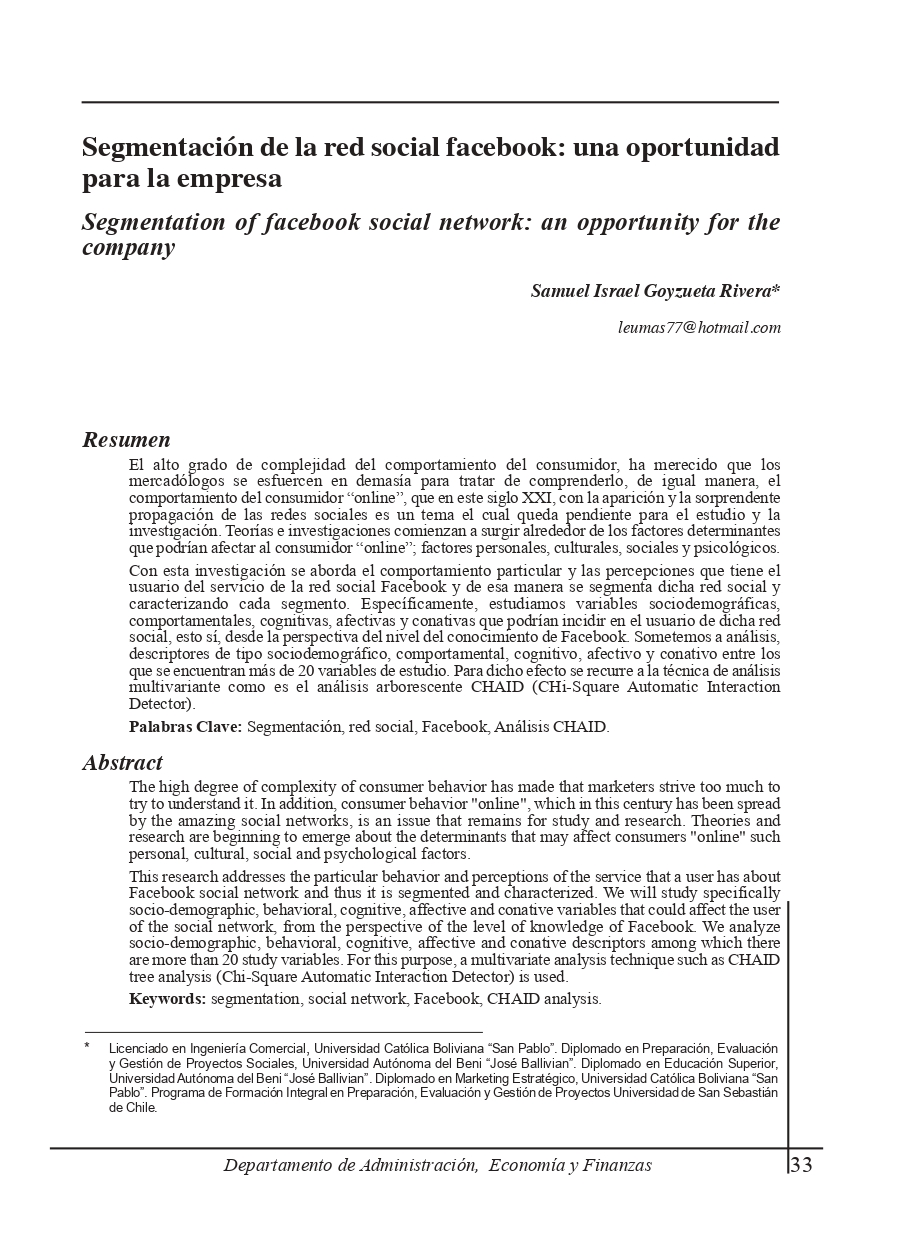Segmentation of facebook social network: an opportunity for the company
DOI:
https://doi.org/10.35319/sqb36627Keywords:
segmentation, social network, Facebook, CHAID analysisAbstract
The high degree of complexity of consumer behavior has made that marketers strive too much to try to understand it. In addition, consumer behavior "online", which in this century has been spread by the amazing social networks, is an issue that remains for study and research. Theories and research are beginning to emerge about the determinants that may affect consumers "online" such personal, cultural, social and psychological factors.
This research addresses the particular behavior and perceptions of the service that a user has about Facebook social network and thus it is segmented and characterized. We will study specifically socio-demographic, behavioral, cognitive, affective and conative variables that could affect the user of the social network, from the perspective of the level of knowledge of Facebook. We analyze socio-demographic, behavioral, cognitive, affective and conative descriptors among which there are more than 20 study variables. For this purpose, a multivariate analysis technique such as CHAID tree analysis (Chi-Square Automatic Interaction Detector) is used.
Downloads
References
ANDERSON, Paul (2007). What is Web 2.0? Ideas, technologies and implications for education. JISC, No.1, Ucrania.
CEBRIÁN, Mariano (2008). La Web 2.0 como red social de comunicación e información. Universidad Complutense de Madrid, No.1, España.
CHECK FACEBOOK (2011). “Check Facebook”.
FACEBOOK (2011). “Facebook Stats”.
FUNDACIÓN DE LA INNOVACIÓN BANKINTER (2007). Web 2.0. El negocio de las redes sociales. No.8, España.
HAIR, Joseph; BLACK, William; BABIN, Barry; ANDERSON, Rolph (2010). Multivariate Data Analysis (7ª ed.). Estados Unidos: Pearson-Prentice Hall.
HERNÁNDEZ, Roberto; FERNÁNDEZ, Carlos; BAPTISTA, Pilar (2006). Metodología de la investigación (4ª ed.). México: McGraw-Hill.
HILL, Thomas; LEWICKI, Pawel (2006). Statistics: methods and applications (1ª ed.). Estados Unidos: StatSoft.
KOTLER, Philip; ARMSTRONG, Gary (2003). Fundamentos de marketing (6ª ed.). México: Prentice Hall.
KOTLER, Philip (2007). Marketing: versión para Latinoamérica (11ª ed.). México: Prentice Hall.
KOTLER, Philip; KELLER, Kevin (2007). Marketing Management (12th ed.). Estados Unidos: Prentice Hall.
LA VANGUARDIA (2010). “Informática educativa, redes sociales”.
LEIVA, Javier (2009). Redes sociales: situación y tendencias en relación a la información y la documentación. BARATZ, No.1, España.
MCDONALD, Malcolm; DUNBAR, Ian (2004). Market Segmentation. Estados Unidos: Elsevier.
O’REILLY, Tim (2005). “What is Web 2.0?”. Disponible en: http://oreilly.com/web2/archive/what-is-web-20.html (consulta: 30/05/2010).
PICÓN, Eduardo; VARELA, Jesús; LÉVY, Jean-Pierre (2004). Segmentación de mercados. España: Pearson Educación.
WALKER, Orville; BOYD, Harper; MULLINS, John; LARRECHÉ, Jean-Claude (2005). Marketing estratégico (4ª ed.). México: McGraw-Hill.
WIKIPEDIA (2010). “Marketing effectiveness”. Disponible en: http://en.wikipedia.org/wiki/Marketing_effectiveness (consulta: 29/06/2010).
WIKIPEDIA (2010). “Red social”. Disponible en: http://es.wikipedia.org/wiki/Red_social (consulta: 29/06/2010).

Downloads
Published
Issue
Section
License
Copyright (c) 2011 Revista Perspectivas

This work is licensed under a Creative Commons Attribution-NonCommercial-ShareAlike 4.0 International License.
La Revista Perspectivas de la Universidad Católica Boliviana, es una revista de acceso abierto, por lo tanto, es de libre acceso en su integridad. Está permitida su lectura, búsqueda, descarga, distribución y reutilización legal en cualquier tipo de soporte únicamente para fines no comerciales, siempre y cuando la obra sea debidamente citada.




